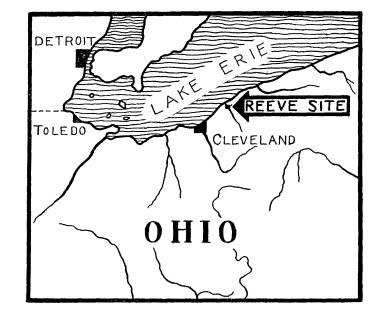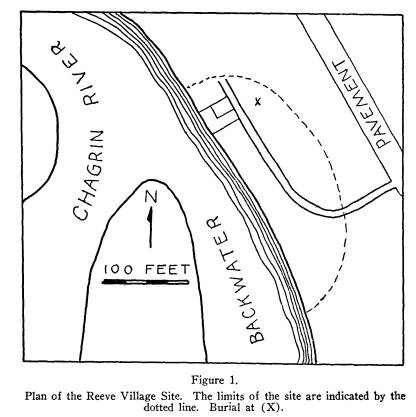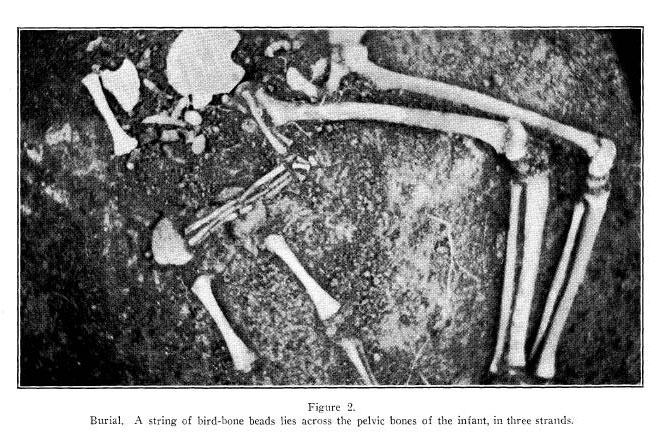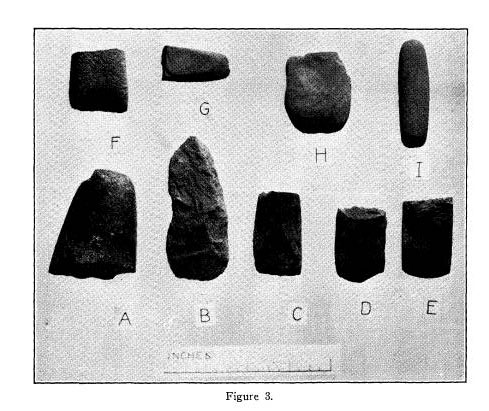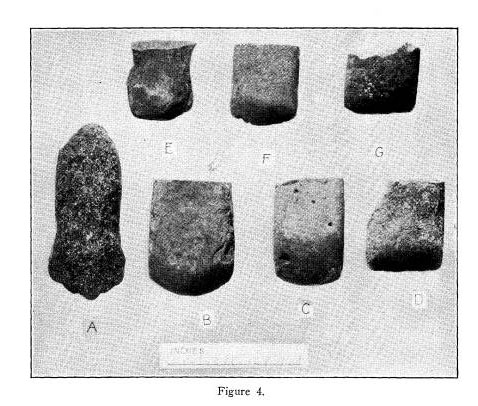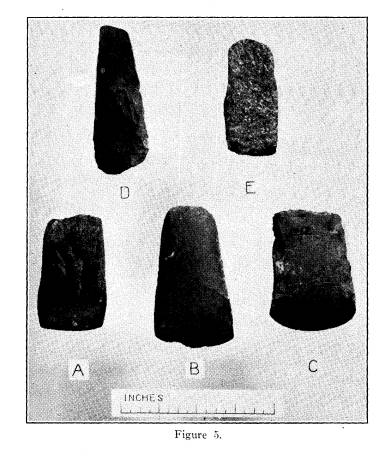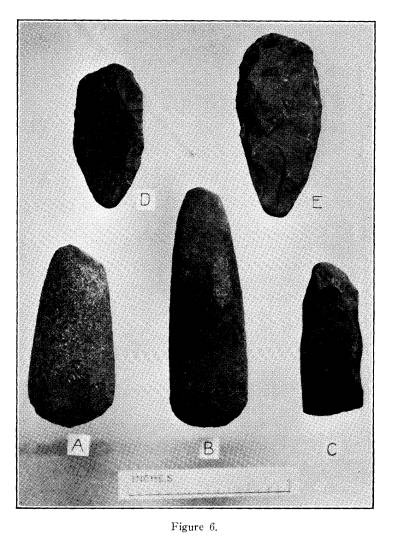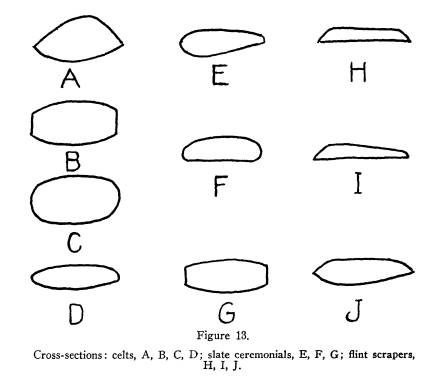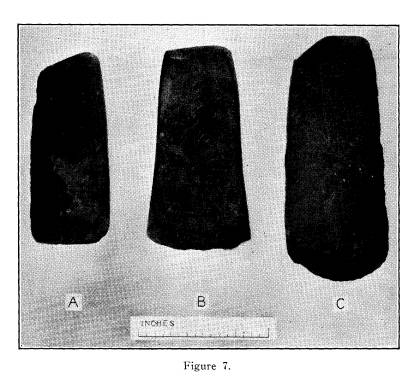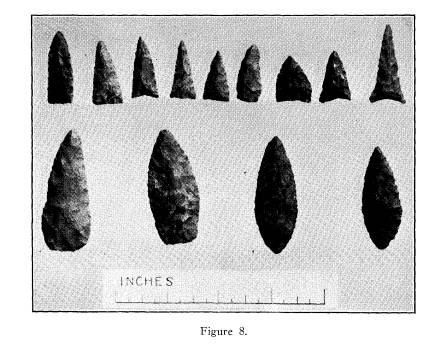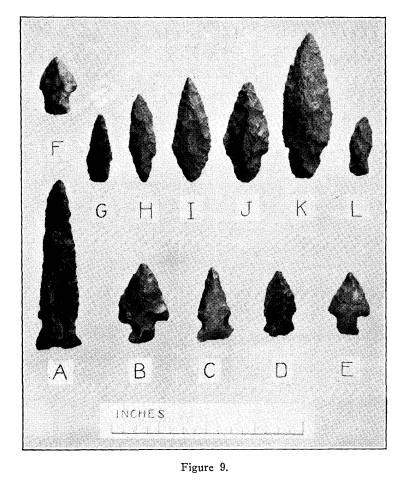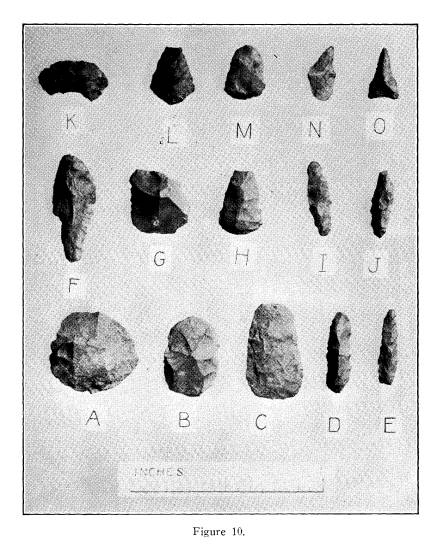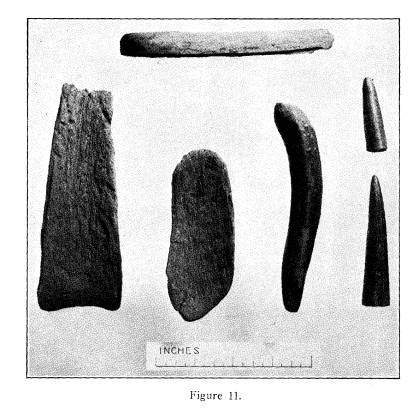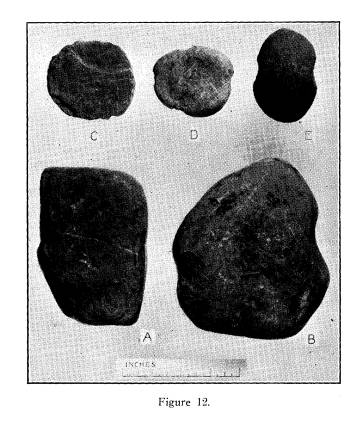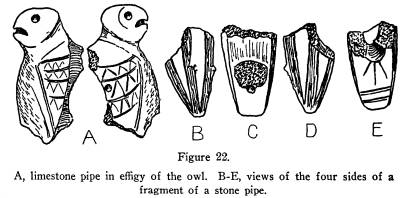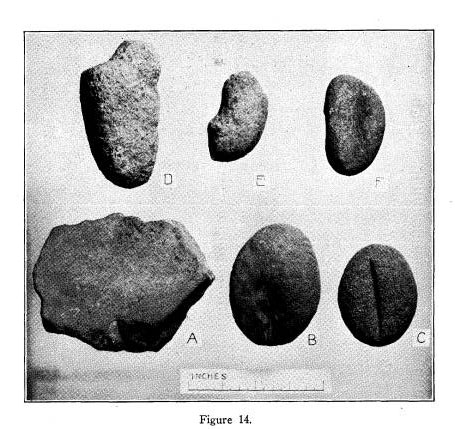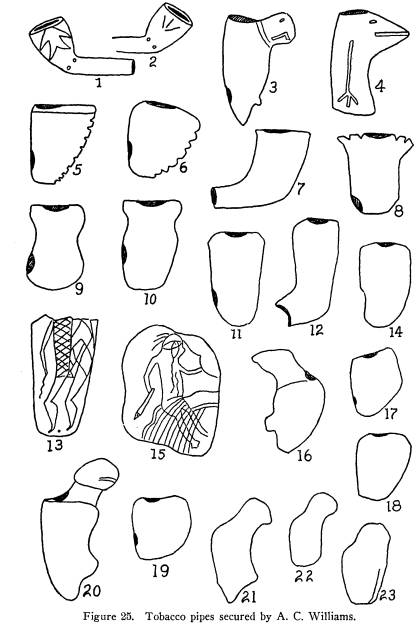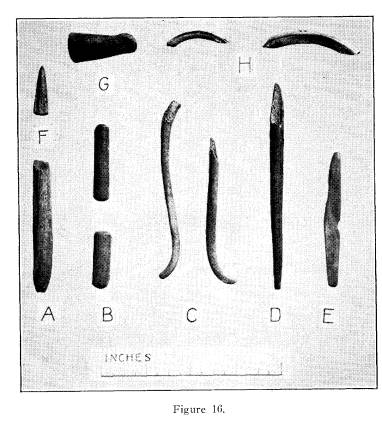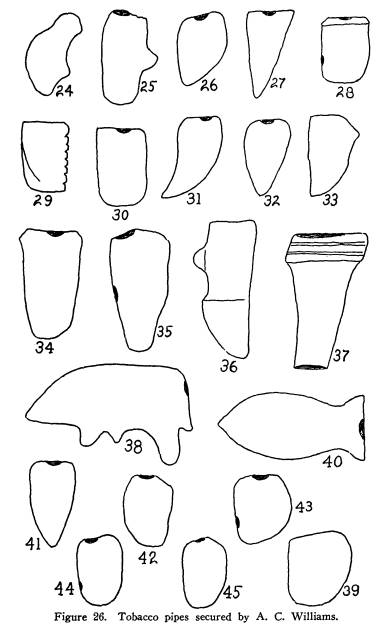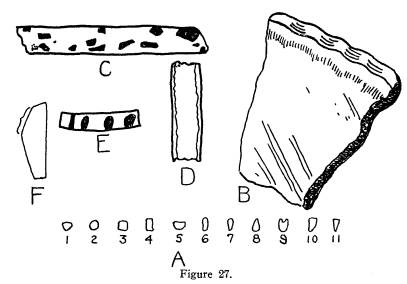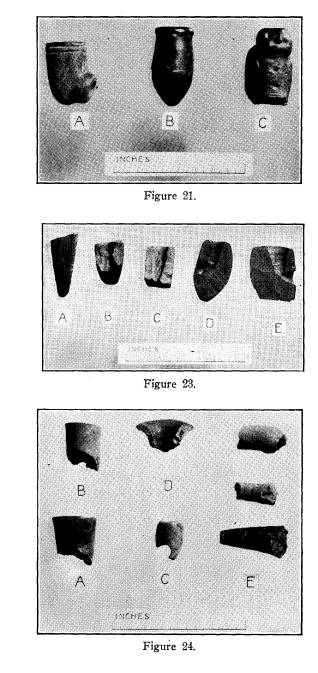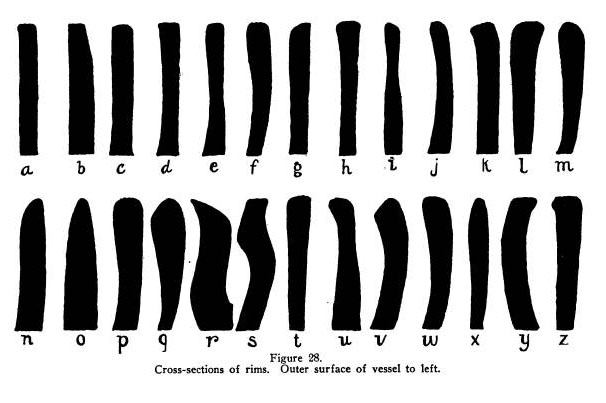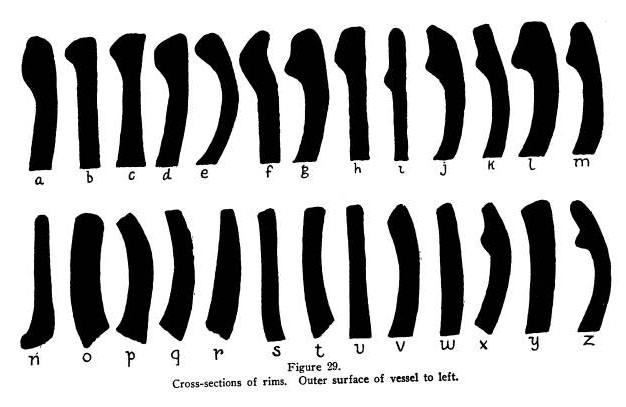Ohio History Journal
|
|
|
(2) |
EXCAVATION OF THE REEVE VILLAGE SITE,
LAKE COUNTY, OHIO
By
EMERSON F. GREENMAN
(3)
TABLE OF CONTENTS
PAGE
Foreword
........................................ 5
Description of
the Site
................................. 5
Burial
........................................
10
Artifacts
............................................. 11
Bibliography
........................................ 31
Appendix ...................................... ..... 32
(4)
EXCAVATION OF THE REEVE VILLAGE SITE,
LAKE COUNTY, OHIO
Foreword
The entire season of 1929 was spent in
locating and examin-
ing a number of aboriginal sites in
northern Ohio, from the
eastern border of the State to the city
of Lorain and in only one
instance more than ten miles from the
shore of Lake Erie. Pre-
vious to 1929 no excavations in the lake
shore region had been
conducted for this Society, and
consequently the first problem
was to locate a promising site. For this
purpose the assistance
of Mr. Sidney S. Wilson, secretary of
Adelbert College, Western
Reserve University, was sought, and
through him contact was
made with Mr. Eugene Vohlers of
Willoughby, who gave the
location of the Reeve Site. Since this
site had been dug indis-
criminately for fifty years or more, the
excavations which were
then begun were of a preliminary nature,
pending the location of
a virgin site. The field staff,
consisting of Mr. Richard Morgan
of Middletown, Ohio, Mr. Warren Stevens
and Mr. William
Rygg of Oak Park, Illinois, began
excavation under the direc-
tion of Mr. Robert Goslin, field
assistant, while the writer made
a number of trips in the effort to find
a more promising site for
the summer's work. Other sites were
located, but excavation of
them gave such meager results that
several returns were made to
the Reeve Site, which was the most
productive of artifacts of
the fifteen or more sites found during
the season. In view of
the fact that the Reeve Site had been
worked so thoroughly, few
measurements were taken, either
vertically or horizontally.
Description of the Site
The Reeve Village Site is in Willoughby
township, Lake
County, one-quarter of a mile south of
the mouth of the Chagrin
(5)
6
OHIO ARCHAEOLOGICAL AND HISTORICAL QUARTERLY
River, on a bluff about thirty-five feet
high on the east side of
the river. No earthworks were found but
the site may origi-
nally have been fortified by a stockade
of logs set in a low wall of
earth. Charles Whittlesey1 describes
a site in the immediate
vicinity of the Reeve Site, with two
walls of earth inclosing an
area at the edge of the river bluff. He
refers to "a blunt point
of land, composed of drift hard pan,
about thirty-five feet high,
at the base of which the river is
rapidly wearing away the mate-
rials." Although in 1929 no projecting
of the bluff was notice-
able, people who have been familiar with
the site for the past
half-century say that from thirty to
fifty feet of land has fallen
into the river within the period of
their memory. The two walls
described by Whittlesey, which ran
parallel a short distance
from one another, were nearly
obliterated at the time of his visit
in 1877, but he traced them for a
distance of about 640 feet.
Permission to excavate was readily
granted by the owner of
the site, Dr. George N. Reeve. As
determined by excavation the
occupied area extended along the bluff
for some 250 feet, and
away from the bluff not more than eighty
feet (Figure 1.). The
stream at the bottom of the bluff is not
the main current of
Chagrin River, but a slow-moving,
shallow bayou which enters
the main stream at the north end of the
village site. The oppo-
site shore of this bayou is a large
island. At the present time
there is a summer cottage with a
fenced-in yard at the edge of
the bluff, the whole covering an area
about thirty by seventy-five
feet upon which no excavations were
made. The road extend-
ing from the pavement to the summer
cottage, paralleling the
edge of the bluff for nearly two hundred
feet, forbade extensive
digging in that part of the site.
Formerly an apple orchard
benefitted from the rich soil, but only
four of the trees were
standing in 1929.
This spot of ground has been well-known
for many years,
probably since its surface was first
broken by the plow, and re-
ports of excavations in the past were
substantiated by a number
1 Superior figures in this article refer
to numbered items in the Bibliography.
|
REEVE VILLAGE SITE EXCAVATION 7 |
|
|
|
of large holes which have never been filled in. Some fifty years ago the brothers James and Joseph Worden dug intermittently upon this and neighboring sites, and a number of the specimens they obtained may be seen in the Museum of the Western Re- serve Historical Society, in Cleveland. (Vohlers has excavated along the bluff and elsewhere, and has a collection of objects from the site. Previous to 1916, Mr. Frederick Houghton of Buffalo, New York, examined the site and found a few objects on the surface which led him to the conclusion that the site was prehistoric.2 In Figures 25 and 26 are drawings of forty- four tobacco pipes which, with six more, were found by ex- cavation by Mr. A. C. Williams of Chagrin Falls. |
8 OHIO ARCHAEOLOGICAL AND HISTORICAL QUARTERLY
REEVE VILLAGE SITE EXCAVATION 9
phase. Detailed comparison with other
specific sites has not
yet been made, and aspect, focus and
component cannot here be
indicated.
Because of its location if for no other
reason, the Reeve
Site is more allied to the Iroquois than
to the Fort Ancient cul-
ture, although the sherds with
curvilinear incised designs (Fig-
ure 36, A, B, C.) place it closer to the
latter than any other
known site ascribed to the Iroquois.
Historically, the identity
of the occupants of this site points to
the Erie Indians, who
were linguistically Iroquois and are
placed on the early maps
along the southern shore of Lake Erie.
The Erie, or Cat Nation,
as they are called in the early records,
were completely destroyed
as a separate unit by the confederated
Iroquois in 1654.4 The
nearest site to the one under
discussion, which has been de-
scribed as a village of the Erie Indians
is near Ripley, Chau-
tauqua County, New York.5
The characteristics of the Reeve Site
are as follows: double
burial; flexion; extension; thick
deposit of artifact-bearing black
earth; situation at edge of a
river-bluff; stockade fortifica-
tion(?); stone celts, mostly rough, many
showing constriction
for hafting; projectile points, flint,
unnotched, predominating;
projectile points, flint, notched or
stemmed; projectile points,
antler; scrapers, flint, keeled;
scrapers, flint, other types; drills,
flint, three types; knives, two types,
unnotched leaf-shaped pre-
dominant; blanks, flint; net-sinkers,
thick, large, and unmodified
except for notches, and thin, with edges
chipped, and notches;
mortar, sandstone, small; rubbing
stones, two with grooves; ham-
merstone, pitted; awls, bird and animal
bones, some bearing
notches; punches, bone or antler;
gouges, antler; flint-chipping
tools, bone, antler, and raccoon
penis-bone; chisels, antler; animal
bone with incised crosshatch design;
fish-scalers, mussel shell,
some perforated; beads, hollow bird
bone; beads, discoidal shell;
pendants, slate, mussel shell, and
perforated animal canine teeth;
gorgets, slate, with and without holes;
combs, effigy, antler; flutes,
bone; tobacco pipes, clay, stone, Ohio
pipestone (Sciotoville flint-
clay), effigies in stone, and probably
elbow clay types, one with
bell-shaped bowl; pottery, bearing
incised, punctate, pressed and
10 OHIO ARCHAEOLOGICAL AND HISTORICAL QUARTERLY
REEVE VILLAGE SITE EXCAVATION 11
12 OHIO ARCHAEOLOGICAL AND HISTORICAL QUARTERLY
REEVE VILLAGE SITE EXCAVATION 13
|
14 OHIO ARCHAEOLOGICAL AND HISTORICAL QUARTERLY |
|
|
|
The mortar itself is five centimeters thick, and the worn sur- face (the face shown in the illustration) is concave. The ma- terial is coarse sandstone, identical with that of the pebble found with it. The latter is 38mm. thick. Rubbing Stones. Five specimens come under this heading. Three are shown in Figure 14, B, C, F. The former is the pebble found with the mortar. C in Figure 14 is 72mm. long, 55mm. wide and 33mm. thick. It has but one groove. F is 72mm. long, 44mm. wide and 25mm. thick, with a groove on both sides. The two remaining specimens are roughly round in outline, with facets formed by grinding. One, of gneiss, is 58mm. in diameter and 40mm. thick. The other is 6omm. in diameter and 35mm. thick. Hammerstone, Pitted. Only a single specimen of this type |
REEVE VILLAGE SITE EXCAVATION 15
16 OHIO ARCHAEOLOGICAL AND HISTORICAL QUARTERLY
REEVE VILLAGE SITE EXCAVATION 17
18 OHIO ARCHAEOLOGICAL AND HISTORICAL QUARTERLY
REEVE VILLAGE SITE EXCAVATION 21
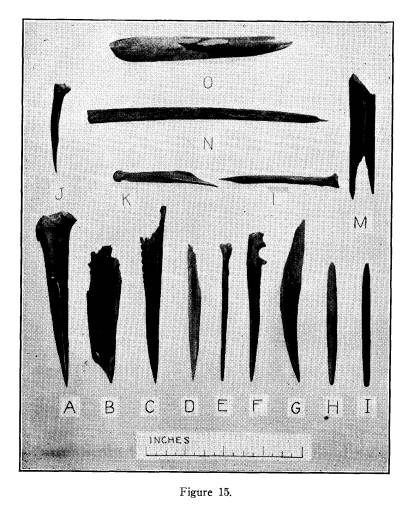
|
|
has a crudely incised figure on the side presented in the illus- tration. In Figure 24, showing pipe-bowls and stems of clay, D is the only one of the so-called bell-shaped type found on the site. This is a type characteristic of the Iroquois sites in northern New York. C is a portion of a small pipe-bowl made of Ohio pipestone, of which material no others were found. All three of the stems (E.) are perforated, but in the middle one the hole emerges before it reaches the end. There is no tempering ma- terial in any of these clay objects, with the exception of minute fragments of yellow mica in B. The surfaces of A and C are highly polished. In Figure 14, D and E, are two objects of calcite which are probably unfinished pipes. At the top of the bowl in D, behind the protruding knob, a hole, 8mm. in diameter and about five in depth, has been started. The record of fifty-two more tobacco pipes from the Reeve Site is preserved in a notebook made by Williams of Chagrin Falls, Ohio, who secured them by excavation. This notebook is now the property of Mr. A. T. Wehrle of Newark, Ohio, and the drawings of these pipes have been reproduced in Fig- ures 25 and 26. These drawings were made by Goodwin of the Museum staff from another set which was copied by the writer from the Williams' notebook. They are therefore not accurate in all details. These pipes were presented by Williams to an educational institution in the East, but attempts to ascertain their present repository have been unsuccessful. In addition to the forty-four pipes illustrated, there were six more of a shape re- sembling number 44 in Figure 26, and one elbow pipe of stone about 15cm. in length. Miscellaneous Objects. These include a piece of slate 52mm. long, which has seen a small amount of artificial modification, and a smooth pebble of quartzite 62mm. long, broken at one end, which may have been used as a rubbing stone or as a net- sinker. A piece of the basal portion of an elk antler, a little over 16cm. long and 92mm. in greatest diameter at base, was at first believed to have been used as a pestle, but close examination of the base revealed no evidence of use. There are two grooves, |
REEVE VILLAGE SITE EXCAVATION 23
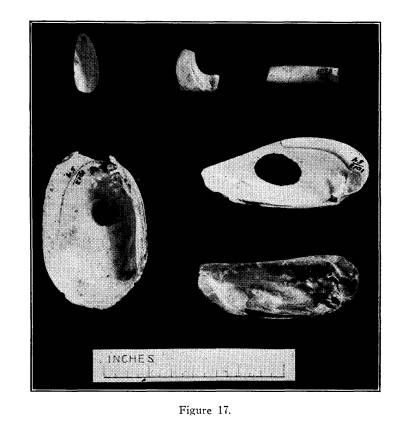
|
|
roughly V-shaped in cross-section, sixty and 70mm. long, and 17mm. apart, on one side, which appear to have been cut in. The only other artificial modification of this piece was done by beavers, the marks of whose teeth are on all edges. Animal Bones. The bones of deer, elk, bear, and of smaller quadrupeds, and of various birds, in particular the wild turkey and the goose, were found on the site at various depths in some profusion (See Catalog List, Appendix, number 61.). Pottery. No entire vessels were found on the Reeve Site, and 402 of the 1606 sherds are portions of rims. Potsherds ranging in size from one-half of an inch to six inches long were found in all parts of the area excavated, and at various depths, from the surface of the ground downward. They exhibit a considerable variety of decorative designs, which may be seen in the illustrations accompanying the pottery classification in the Appendix, pages 47-58, Figures 30-37. Paste. Under this term come the two types of ma- terial of which the pottery of the Mississippi Valley is made, the clay itself, and the tempering materials, the latter consisting in the present instance of fragments of granitic rocks or pieces of ground-up mussel-shell. The texture of these sherds varies in fineness, and in most the surface exposed by fracture is rough and lumpy, with cracks between the lumps. Both surfaces, and the edges of most sherds, are bluish gray or reddish brown, but the former color shows dark or light reddish brown when scratched with a metal implement. This is true both of shell and grit tempered sherds. Some sherds show a distinct lamina- tion as to color and texture, with blue, or dark bluish clay at the center, lined on both sides with light brown, which is lighter on the outer than on the inner surface, the latter surface being sometimes of a lighter blue-black than the central layer. In such sherds as this the inner bluish clay is very fine in texture, show- ing minute fragments of iron pyrites, gold-colored. The outer lamina of brown clay are slightly coarser, and show the same minute particles of tempering material, which are scarce through. out the entire sherd. A few shell-tempered sherds show a simi- |
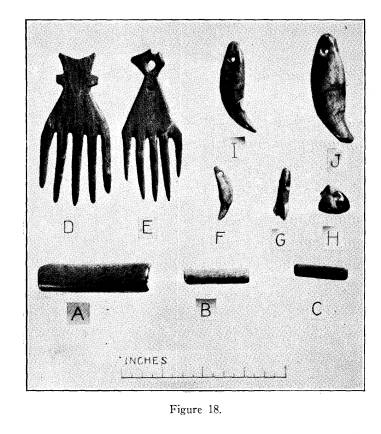
|
||
|
REEVE VILLAGE SITE EXCAVATION 25
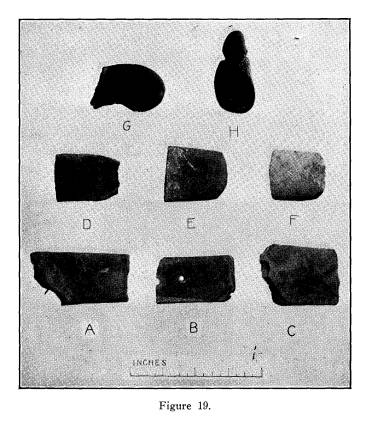
|
|
near the surface as to impart an uneven appearance and to cause short, shallow cracks. The paste of some sherds contains an admixture of sand, which gives a gritty feeling to the surface. In Figure 27, C, is a cross-section showing the frequency, size and shape of fragments of micaceous materials as they show up in the broken edge of a sherd. The largest fragment seen is one-half of a millimeter in thickness. In the shell-tempered sherds the fragments of shell vary in size from the barely visible to irregularly shaped pieces six or 8mm. across, and usually no more than half a millimeter thick. The larger fragments usually lie with planes parallel to inner and outer surfaces. The mix- ture is quite uniform, and fragments of shell show on both surfaces. Three rim-sherds and one decorated body sherd show the use of both grit and shell in tempering. Three hundred and eighty-three rim-sherds are tempered with grit, and sixteen with shell. One hundred and ninety-eight decorated body sherds are tempered with shell, and of the 1207 undecorated body sherds, only eighty-six are tempered with shell. The hardness of these sherds on the mineralogical scale has been determined by Griffin (See table, Appendix.). Surface Finish. This term is described by Guthe6 as re- ferring "to that dominant feature of a ceramic specimen which is the result of a uniform treatment of the major part of its sur- face." In the pottery discussed herein it refers to a modification of the surface by smoothing or scraping while the clay is in a plastic condition, by impression or incision, with results which are distinct from decoration. Outer surfaces: Some sherds are smooth, but not sufficiently so to reflect light enough to give the appearance of a polish. The majority have the surface roughened by impression with objects giving a bark-like appearance, and a few show the im- pression of twined two-ply cords in long vertical parallel lines, occasionally at an angle to the vertical or in two groups of par- allel lines one superimposed upon the other at an oblique angle. This roughening of surfaces either covers the entire body of the vessel, with the exception of the base, or extends only as |
26 OHIO ARCHAEOLOGICAL AND HISTORICAL QUARTERLY
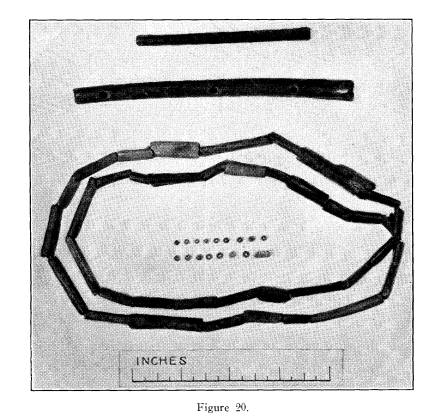
|
|
far as the shoulder, from which to the lip the smoothed surface usually bears an incised design accompanied by punctate lines. In some cases the design is made upon a surface thus roughened to the outer edge, and sometimes across the lip. One grit-tem- pered sherd shows a bark-like roughening of the surface over which narrow lines have been cut when the clay was relatively dry, but previous to firing. These lines are about half a milli- meter in depth and width, and almost perfectly straight to the eye. Inner surfaces: Some sherds are rough and gritty, to an extent comparable to both fine and coarse sandpaper. Others show shallow rounded depressions made probably by the finger tips in modeling the vessel. As described above, the inner sur- faces of many grit-tempered sherds are rough, due to the in- trusion or protrusion of the larger pieces of tempering material. Most sherds of this type have meandering jagged cracks which do not extend through the outer surface, where such cracks are rare. Sherds containing sand in addition to pounded granite show no such cracks. Most of the sherds, whether tempered with grit or shell, have a discoloration on the outer surface due to handling or to smoke and fire, and coatings or accumulations up to one and a half millimeters thick of carbonized grease on both outer and inner surfaces. Form. There are no entire vessels from the Reeve Site, but sherds five or six inches in vertical length, showing portions of the rim, neck and shoulder, and sherds from the basal portion, give some indications of the predominant shapes. The largest portion of a single vessel is that of the very small one in Figure 30, B, with a cross-section as in Figure 28, r. This sherd is 33mm. high and 9mm. thick, and bears no design. It is remotely possible that it is a fragment of the bowl of a tobacco pipe. Fragments of larger vessels indicate forms of this type, with variations as to constriction of neck, width of lip and presence or absence of a collar, or enlargement of the rim just beneath the lip. Bases are always rounded. Eleven rim-sherds have scallops on the lip; on six of these the scallops are narrow, forming notch-like depressions from six to 13mm. |
28 OHIO ARCHAEOLOGICAL AND
HISTORICAL QUARTERLY
across, and from about one to 6mm. deep.
The scallops of four
sherds are from thirty-eight to 51mm.
wide, and from six to
13mm. high. The scallop on the remaining
sherd (Figure 32, D,
a repaired sherd made from four smaller
ones.) is from twenty-
one to 23cm. long. Only two sherds show
handles (Figure 33,
B, and Figure 34, C.). The sherd
illustrated in Figure 35, B,
also originally had a handle. One
portion of a large vessel
(Figure 34, A.) has large oval
depressions extending upward
from the shoulder, 45mm. long and one
and one-half millimeters
in depth. The inner surface of this
sherd bulges at the points
directly opposite these depressions. At
the shoulder there is a
row of smaller oval depressions lying in
oblique positions. In
addition to the above described handles,
the only application of
clay to the body of vessels is just
beneath the lip, to form a
crimped pattern either by pinching up
the plastic clay between
the fingers, or by impression with the
side of a round stick, or
by pressing the edge of a thin implement
into the ridge of clay
and working it from side to side. On
five grit-tempered sherds
strips of this crimped raised pattern
have fallen off.
While some sherds are wider in
cross-section at the lip
than beneath, only one has anything
resembling a collar (Cross-
section, Figure 28, s.).
Lips are of the following main types:
horizontal, as in
Figure 28, b, f; slanting downward to
outer surface of rim,
as in g, k; slanting downward toward
inner surface of rim, as
in i; broadly or narrowly rounded, as in
j, p; gabled, with slant
on each side of a central ridge, as in
o, q; and consisting of a
ridge only, as in r. Sherds in which the
lip, or a portion of it,
forms a straight line, connect with the
sides either in curves
or sharp angles.
Decoration. Under this heading come those modifica-
tions of the surfaces of sherds which
have not already been
dealt with under discussion of Form,
where the crimped pat-
tern for example, while it may be looked
upon as a decorative
element, consists in the addition of
clay to the surface with a
consequent alteration of the form of the
vessel. The decorations
discussed in the present section are
formed by modification of
30
OHIO ARCHAEOLOGICAL AND HISTORICAL QUARTERLY
the surface rather than by the addition
of materials. Two tech-
niques were used, incision and
impression. The incised lines
are straight in all but three sherds.
They vary in width from
6mm. to half a millimeter, and in depth
from the barely visible
to 3mm. The spaces between them are from
1.4mm. to 16mm.
wide. On the majority of sherds the
lines are drawn as evenly
as the tools used would permit, but on
some, lines apparently
intended to be parallel run into one
another, or present an
uneven appearance. Many of the lines
have fine ridges or
striations running parallel to the
sides. Some were incised
with sticks which were rectangular in
cross-section, and others
indicate sticks that were oval or
elliptical in cross-section.
Many of the lines have irregular lumps
of clay, or long ridges,
no more than one-half of a millimeter
high, at their edges on
the level of the surface of the pot,
indicating a degree of plas-
ticity of the clay allowing such ridges
or lumps to be pushed up
in the incising process.
Marks made by pressing are mainly
punctate, formed by
pressing the end of a blunt or pointed
implement a short dis-
tance into the clay. These punctate
marks, which are usually
arranged in horizontal rows, vary in
outline as shown in Figure
27, A. Punctate marks vary in depth from
half a millimeter to
3mm. Some of them were made with an
instrument the end
of which was notched or ridged (Figure
27, A, 9.). The only
other type of pressed technique is in
the form of shallow oval
depressions already discussed, at the
neck of the rim-sherd in
Figure 34, A.
One sherd is unique in having diagonal
and parallel lines
apparently raised, although they are not
above the general sur-
face (Figure 37, A, and division 12 in the pottery
classification
in the Appendix.). These lines are
simply narrow strips of
the surface of the vessel left between
rows of short incisions,
the latter parallel to one another and
at right angles to the lines.
This sherd is of great interest, since
others of the type were
found in excavations in 1930 near Cleveland,
and there are
several of them in private collections
in Sandusky, nearly eighty
miles west of the Reeve Site.
REEVE VILLAGE SITE EXCAVATION 31
Terminology. The sherds described in the Appendix
show two types of diagonal line, those
forming connecting
groups at angles to one another, or with
horizontal or perpendicu-
lar incised lines, and those, never more
than 13mm. long, in rows
the units of which are perpendicular or
slanting and which
do not connect with one another or with
horizontal lines. The
former type is referred to as diagonal,
and the latter as short
or as slanting. The former,
because of their greater length, are
always incised and the latter are
sometimes incised and some-
times pressed, or gouged out by the
thumb-nail or other imple-
ment. The term punctate refers to
indentations pressed as by
the side of a stick, into the lip and
extending its width, or into
the outer edge of the lip and going down
the distance of its
depth on the outer surface. Some of the
entire vessels repre-
sented by rim-sherds may have had more
decorative elements
than are shown on the fragment. This is
particularly true of
those in division 3.3. Some or possibly
all of these thirty-one
sherds may belong with division 3.2,
since in all the break is so
close to the bottom horizontal line as
to make it impossible to
say with certainty that there were not
punctate marks below
that line.
Bibliography
1 Ancient Earthworks--Northern Ohio, by Charles Whit-
tlesey, in Western Reserve Historical
Society Tracts (Cleveland,
1870-), II (1888), 36.
2 "The
Characteristics of Iroquois Village Sites of Western
New York," by Frederick Houghton,
in American Anthropol-
ogist (Menasha, Wisconsin, 1888-), XVIII (1911), 515.
3 "Ancient Aztalan," by S. A. Barrett, in
Public Museum
of the City of Milwaukee Bulletin (Milwaukee,
191O-), XIII
(1933), 370-1.
4 Jesuit Relations and Allied
Documents; edited by Reuben
Gold Thwaites (Cleveland, 1896-19O1),
XLII, 177-183.
5 "The Ripley Erie Site," by Arthur C. Parker,
in New York
Vol. XLIV--3
32
OHIO ARCHAEOLOGICAL AND HISTORICAL QUARTERLY
State Museum Bulletin (Albany,
1848-), nos. 235, 236 (1920),
part 1, pp. 246-307.
6 Standards of Pottery Description, by Benjamin March;
with an Introductory Essay by Carl E.
Guthe, in Museum of An-
thropology of the University of Michigan
Occasional Contribu-
tions (Ann Arbor, Michigan, 1932-), no. 3 (1934), 2.
Appendix
Celts
I. Rectangular in Transverse
Cross-section, Faces Flat, Sides at
Right Angles to Plane of Faces, or
Rounded. Symmetrical.
12 celts.
Fig. 4. B: sandstone, 87mm. long, 65mm.
wide, 14mm. thick. Broken, blunt
end missing.
C: sandstone, 80mm. long, 53mm.
wide, 19mm. thick. Broken, blunt
end missing.
D: probably gneiss, 69mm. long. 57mm.
wide, 17mm. thick. Broken, blunt
end missing.
F: sandstone, 6omm. long, 50mm.
wide, 18mm. thick. Broken, blunt
end missing. Corners of cross-
section rounded. Parts of both
faces reddish, as if from pigment.
Fig. 3. E: siliceous slate, 47mm. long, 30mm.
wide, 13mm. thick. Broken, blunt
end missing.
F: quartzite, 38mm. long, 35mm.
wide, 19mm. thick. Broken, blunt
end missing. Corners of cross-
section rounded.
G: slate, 42mm. long, 20mm. wide,
11mm. thick. Broken, blunt end
missing.
REEVE VILLAGE SITE EXCAVATION 33
Fig. 7, A: quartzite, 144mm. long, 63mm.
wide, 18mm. thick. No cutting
edge. Unfinished, or perhaps in-
tended as a gorget.
B: probably sandstone, 149mm. long,
79mm. wide, 19mm. thick.
C: quartzite, 181mm. long, 75mm. wide,
16mm. thick. No cutting edge.
Perhaps unfinished, or intended as
a gorget. Opposite face deeply
scratched.
Fig. 5. C: quartzite, 81mm. long, 55mm. wide,
18mm. thick. Flaring edge. Broken,
blunt end missing. Edges jagged.
Others, One piece of middle portion of a
celt, sandstone, 60mm. wide, 18mm.
thick.
2. Symmetrically
Elliptical in Cross-section.
3 celts.
Fig. 4, A: mica schist, 130mm. long, 57mm.
wide, 35mm. thick. Cross-section
as in Figure 13, C.
Fig. 3, I: sandstone or slate, 64mm. long,
19mm. wide, 9mm. thick. Made
from a water-worn pebble with no
surface altered except at the cut-
ting edge. Cross-section roughly as
in Figure 13, D.
Fig. 6, A: syenite, 114mm. long, 52mm. wide,
33mm. thick. Polished 35mm. or
more up from cutting edge. Cut-
ting edge missing.
3. Faces Rounded, Sides Flat.
4 celts.
Fig. 4, G: syenite, 47mm. long, 53mm. wide,
30mm. thick. Cross-section as in
34
OHIO ARCHAEOLOGICAL AND HISTORICAL
QUARTERLY
Figure 13, B. This may be a piece
of the blunt end or the cutting end.
Fig. 3, A: syenite, piece of a blunt end, 65mm.
long, 50mm. wide, 29mm. thick.
Cross-section as in Figure 13, B.
Others, I. syenite, 100mm. long, 47mm. wide,
30mm. thick. Broken, cutting edge
missing.
2. syenite, 34mm. thick. Fragment of
cutting edge.
4. One Face Rounded, Opposite Face Flat.
5 celts.
Fig. 6, B: syenite, 152mm. long, 48mm. wide,
30mm. thick.
Fig. 5, B: probably syenite,
92mm. long,
50mm. wide, 18mm. thick. Sides
scarred by pecking.
Others, 1. probably syenite,
99mm. long,
32mm. wide, 18mm. thick, sides
parallel and scarred by pecking.
End roughly pointed, also scarred.
Cutting edge missing.
2. probably syenite, 95mm. long 39-
mm. wide, 20mm. thick. Edges
pecked and irregular.
3. slate, 45mm. long, 27mm. wide,
13mm. thick. Edges pecked.
5. Rough Surfaces, with Cross-sections
Asymmetrical.
5.1 Parallel sides.
16 celts.
Fig. 3, C: slate, 49mm. long, 29mm. wide,
10mm. thick. Broken, blunt end
missing.
D: slate, 45mm. long, 30mm. wide,
12mm. thick. Broken, blunt end
missing.
REEVE VILLAGE SITE EXCAVATION 35
H: probably slate, 47mm. long, 40mm.
wide, 9mm. thick. A water-worn
flat pebble.
Fig. 6, C: slate, 94mm long,
38mm. wide,
20mm.
thick. Shallow notches for
hafting. Cross-section roughly as
in Figure 13, A.
Others, 1. hornblende schist,
90mm. long,
39mm. wide, 21mm. thick. Appar-
ently broken, blunt end missing.
Cross-section roughly rectangular.
2. slate, 75mm. long, 34mm. wide,
17mm. thick, cutting edge rounded.
Blunt end jagged as if broken.
3. syenite, 80mm. long, 37mm. wide,
17mm. thick, edges scarred by
pecking.
4. probably syenite, 75mm. long,
41mm. wide, 17mm. thick, one sur-
face approaching the flat, the other
roughly rounded. Edges jagged,
sides parallel, ends rounded. Both
ends might be cutting edges.
5. hornblende schist, 103mm. long,
51mm. wide, 26mm. thick. Large
facets where flakes have been
struck off. Sides roughly parallel,
blunt end as if broken off, and
missing.
6. probably slate, 85mm. long, 43mm.
wide, 24mm. thick. Large facets,
both ends roughly rounded, sides
roughly
parallel. Cross-section
roughly as in Figure 13, A.
7. diorite, a piece of a cutting edge,
75mm. long, 32mm. thick, 53mm.
wide. Cross-section roughly as in
36
OHIO ARCHAEOLOGICAL AND HISTORICAL
QUARTERLY
Figure 13, A. Flat face very
rough, as if the piece had been split
longitudinally. Other face highly
polished.
8. slate, a piece of a blunt end, 40mm.
long, 40mm. wide, 15mm. thick.
Cross-section roughly rectangular.
9. slate, a piece of a cutting end,
50mm. long, 36mm. wide, 10mm.
thick.
Cross-section roughly rec-
tangular.
10. slate, a piece of a blunt end, 58mm.
long, 36mm. wide, 16mm. thick.
Cross-section as in Figure 13, A.
11. slate, a
piece of a blunt end, 72mm.
long, 72mm. wide, 26mm. thick.
Cross-section as in Figure 13, A.
12. slate, a piece of a blunt end, 98mm.
long, 72mm. wide, 31mm. thick.
Cross-section roughly as in Figure
13, A. Very rough, perhaps un-
finished.
5.2 Sides constricted toward blunt end.
10 celts.
Fig. 3, B: slate, 86mm. long, 32mm. wide,
17mm. thick.
Fig. 5, D: slate, 96mm. long, 36mm. wide,
9mm. thick. Cross-section roughly
rectangular.
E: probably syenite, 75mm. long,
35mm. wide, 10mm. thick. All sur-
faces rough except cutting edge.
Constriction slight. This celt has a
twist in the plane of the faces.
A: slate, 77mm. long, 45mm. wide,
14mm. thick. Constriction slight.
REEVE VILLAGE SITE EXCAVATION 37
Sides slightly indented by pecking
as if for hafting.
Others, 1. slate, 120mm. long, 43mm.
wide,
18mm. thick. Constriction slight.
2. slate, 91mm. long, 43mm. wide,
16mm. thick.
3. slate, 108mm. long, 48mm. wide,
20mm. thick. Constriction pro-
nounced.
4. slate, piece of blunt end, 45mm.
long, 47mm. wide, 15mm. thick.
Sides polished.
5. slate, 63mm. long, 38mm. wide,
18mm. thick. Blunt end jagged.
6. slate, 66mm. long, 30mm. wide,
15mm. thick. Blunt end jagged.
5.3 Sides constricted towards cutting
edge.
4 celts.
Fig. 6, D: slate, 93mm. long, 45mm. wide,
18mm. thick. A water-worn pebble,
with no alteration on side opposite
that in picture.
E: slate, 118mm. long, 53mm. wide,
14mm. thick. Cutting edge 15mm.
wide.
Others, 1. slate, 18mm. long, 54mm. wide,
24mm. thick. Constriction much
less than in F and G. Blunt end
jagged.
2. slate,
107mm. long, 49mm. wide,
12mm. thick. Constriction much
less than in F and G. Blunt end
jagged. Cutting edge jagged, per-
haps unfinished.
38
OHIO ARCHAEOLOGICAL AND HISTORICAL
QUARTERLY
5.4 Outline indeterminable.
2 celts.
Fig. 4, E: Blunt end of a notched celt, dark
purplish slate, 60mm. long, 50mm.
wide, 16mm. thick.
Others, 1. piece of blunt end, 58mm. long,
48mm. wide, 20mm. thick. Material
granular like quartz, but contains
mica. Cross-section roughly as in
Figure 13, C.
Projectile Points
1. Unnotched, Flint.
1.1 Triangular. Mostly thin, well made. A few with con-
cave bases or sides. Outlines vary
slightly. Figure 106,
top row.
76 specimens.
Color of flint, mostly black to me-
dium gray, and dull in all shades.
Only two show the translucent
quality suggestive of Flint Ridge
Material. Two others are reddish
brown, one apparently unfinished
and exhibiting a portion of the
brown weathered surface of the
original block of flint. This one is
35mm. long and 22mm. wide. Five
show a flake technique, one of
which is the one just described.
Both faces are unaltered in these
five, except for coarse secondary
chipping at the edges. All but one
of the remainder show secondary
chipping at the edges of the flaked
surfaces. Most of them are less
than 39mm. long. The longest is
55mm., and the shortest is 17mm.
REEVE VILLAGE SITE EXCAVATION 39
One has the extreme dimensions of
31mm. long, 10mm. wide, with a
triangular outline. The longest
specimen in the entire group, with
an outline like that in Figure 106,
upper row, second from left end,
is 55mm. long, 23mm. wide. Ma-
terial, light gray.
1.2 Constricted base.
3 specimens.
Fig. 8, lower row, second from
left end
55mm. long.
Others, 1. 57mm. long.
2. 43mm. long.
1.3 Leaf-shaped outline.
16 specimens.
Fig. 8, lower row left end. 60mm. long,
25mm. wide.
Others, The remainder vary from 24mm. to
55mm. in length. One shows a
flaked surface with secondary chip-
ping at edges.
1.4 Elliptical,
pointed at both ends.
4 specimens.
Fig. 8, lower row, second from right end,
56mm. long.
Others, The remainder are from 55mm. to
59mm. long.
1.5 Elliptical. Greatest diameter at one
side of center.
2 specimens.
Fig. 8, lower row, right end. 49mm. long.
1.6 Outlines of various types. Roughly
made and thick.
Unfinished or rejected.
38 specimens.
Most of the outlines in Figure 8,
and in Figure 10, B, C, H, L and M,
40 OHIO ARCHAEOLOGICAL AND
HISTORICAL QUARTERLY
are approximated. They vary from
52mm. to 15mm. in length, from
33mm. to 14mm. in width, and from
6mm. to 17mm. in thickness.
1.7 Broken.
40 specimens.
None show notches, but might if the
bases were present. One piece of a
triangular point has a flaked surface
on one face, with secondary chip-
ping.
2. Notched
12 specimens.
Fig. 9, A, B, C, and F resemble Flint Ridge
material. F is light pink, A is shiny
black, and C, B are gray. The re-
mainder vary from dull black to
a cherty gray. D and G-J are of
the dark or black flint characteristic
of most of the unnotched forms.
The same is true of F, Figure 10,
which may or may not be regarded
as a notched point. The reverse of
D, Figure 9, is flaked, with slight
secondary chipping near the point
on both edges.
Dimensions, Figure 9,
A, 9cm. long.
B, 41mm.
C, 39mm.
D, 34mm.
E, 33mm.
F, 31mm.
G, 36mm.
H, 42mm.
I, 56mm.
J, 53mm.
REEVE VILLAGE SITE EXCAVATION 41
K, 77mm.
L, 31mm.
3. Made of Antler.
4 specimens.
Fig. 11, lower right end. 86mm. long, 17mm.
diameter at base. Hole 8mm. in
diameter, 17mm. deep, tapering.
upper, right end. 49mm. long, 8mm.
diameter. Hole 6mm. diameter,
7mm. deep, tapering.
Fig. 12, F: 27mm. long, 8mm. diameter at
base. Hole 4mm. diameter, 15mm.
deep. Rounded at inner end.
Others, 1. 88mm. long, 19mm.
diameter at
base, hole 25mm. deep and 6mm.
in diameter, rounded at inner end.
Base ragged as if broken.
2. 78mm. long, 15mm. diameter at
base. Hole 10mm. deep, 6mm. in
diameter, bluntly rounded at inner
end.
Scrapers
1. Keeled, with Cutting Edge
Thick.
11 scrapers.
Fig. 10, H: 33mm. long, 22mm. wide, 6mm.
thick. The face opposite that in
the picture is flaked.
M: 28mm. long, 22mm. wide, 6mm.
thick.
Others, The remainder vary from 21mm. to
26mm. long. One has one flaked
face, with slight secondary chip-
ping at edges. Longitudinal cross-
sections of all these keeled types as
in Figure 13, H and I.
42
OHIO ARCHAEOLOGICAL AND HISTORICAL QUARTERLY
2. Outlines Similar to the Keeled Types,
but with Longitudinal
Cross-sections as in Figure 13, J.
13 scrapers.
Fig. 10, L: 30mm. long, 25mm. wide, 7mm.
thick.
Others, The remainder vary in thickness
from 6mm. to 9mm., in length from
27mm. to 37mm.
3.
Other Types.
3 scrapers.
Fig. 10, G: 31mm. square, 12mm. thick. Sec-
ondary chipping on lower and left
sides. The opposite surface is
flaked with no secondary chipping.
K: 37mm. long, 20mm. wide, 10mm.
thick.
F: 55mm. long, 8mm. thick. This
may be a type of hafted scraper.
It is referred to under Projectile
Points.
Drills
1. Long and Narrow.
6 drills.
Fig. 10, D: 42mm. long, 12mm. wide, 10mm.
thick.
E: 39mm. long, 10mm. wide, 7mm
thick.
I:
38mm. long, 13mm. wide, 7mm.
thick.
J:
35mm., long, 10mm. wide, 6mm.
thick.
Others, 1. 41mm. long, 11mm.
wide, 10mm.
thick, very rough.
2. 29mm. long, 12mm. wide, 7mm.
thick. Has suggestion of a shoul-
der near base.
REEVE VILLAGE SITE EXCAVATION 43
2. Basic Triangular Outline.
1 drill.
Fig. 10, O: 25mm. long, 15mm. wide, 5mm.
thick.
3. As in Figure 10, N.
1 drill.
28mm. long, 16mm. wide, 8mm.
thick. Shows portion of original
weathered surface.
Knives
1. Basically Triangular, Blunt Ends,
Rounded Corners.
4 knives.
Fig. 10, C: 50mm. long, 29mm. wide, 8mm.
thick. Surface opposite that in pic-
ture is flaked, with some secondary
chipping at edges.
Others, 1. 45mm. long, 23mm. wide, 8mm.
thick.
2. 40mm. long, 22mm. wide, 8mm.
thick.
3. 44mm. long, 23mm. wide, 8mm.
thick.
2. Not Symmetrical.
1 knife.
This resembles the detached broken
edge of a celt. Material, siliceous
slate.
50mm. long, 15mm. wide,
6mm. thick. The side opposite the
cutting edge is jagged. One end
pointed but not sharp, other end
more or less rounded.
Blanks
1. Circular or Oval in Outline.
2 blanks, flint.
Fig. 10, A: 45mm. diameter, 18mm. thick.
B: 42mm. long, 12mm. thick.
44
OHIO ARCHAEOLOGICAL AND HISTORICAL QUARTERLY
Net-sinkers
1. Large, Rough and Thick. Unmodified
Except for Notches.
12 net-sinkers.
Fig. 12, A: 131mm. long, 88mm. wide, 37mm.
thick. Siliceous schist.
B: 155mm. long, 140mm. wide, 30mm.
thick. Limestone. This one shows
slight use as an anvil on both faces
at center.
E: 80mm. long, 53mm. wide, 36mm.
thick. Sandstone.
Others, The largest specimen is 160mm.
long, 147mm. wide, and 24mm.
thick. The thickest is 39mm. None
of the entire eleven specimens has
more than two notches. Materials,
quartzite, siliceous schist, sandstone
and slate.
2.
Discoidal, Roughly Circular in
Outline.
16 net-sinkers.
Fig. 12, C: 75mm. diameter, 8mm. thick. This
specimen has no notches.
D: 67mm. diameter, 11mm. thick. Four
notches. Edges not altered except
for the notches. Faces not altered.
Others, Four are similar to D in Figure 12
in that the edges are unaltered ex-
cept for the notches. One of these
has four notches, one has three,
and the remainder two. The edges
of the rest are more or less chipped.
In size the net-sinkers of this class
not illustrated range from 62mm.
to 84mm. in diameter. Materials,
slate, siliceous schist and sandstone.
One of these, which has been
REEVE VILLAGE SITE EXCAVATION 45
stained by an organic deposition,
shows the mark of the cord in
lighter color from one notch to the
other across one face. This mark is
from one to 2mm. in width.
Slate Ceremonials
1. Rectangular in Transverse
Cross-section, Faces Flat, Sides
at Right Angle to Plane of Faces.
Corners of Cross-section
Square or Rounded. Symmetrical, Surfaces
Smooth.
1.1
3 fragments.
Fig. 19,
A: 72mm. long, 42mm. wide, 13mm.
thick. Sandstone.
B: 60mm. long. One complete hole
and two others with edges missing.
The two holes at left are 13mm.
distant from one another. Diam-
eter of holes, 4mm.
Others, The remaining specimen is of slate
with both ends missing. 38mm.
wide, 49mm. long, 9mm. thick.
One face shows diagonal parallel
scratches, probably intentional.
2.
Symmetrically Elliptical in
Cross-section. Surfaces Smooth.
3.1
1 fragment.
Fig. 19, D: 48mm. long, 37mm. wide, 13mm.
thick. Cross-section as in Figure
13, E.
Surfaces brown, interior
gray.
3.
Faces Rounded, Sides Flat. Surfaces Smooth.
3.1
1 fragment.
Fig. 19, E: 47mm. long, 42mm. wide, 11mm.
thick. Cross-section as in Figure
13, G.
46 OHIO
ARCHAEOLOGICAL AND HISTORICAL QUARTERLY
4. One Face Rounded, Opposite Face
Flat. Surfaces Smooth.
4.1
1 fragment.
Fig. 19, F: 43mm. long, 38mm. wide, 11mm.
thick. Cross-section as
in Figure
13, F. Pecking at
center of round-
ed face.
5. Rough and Uneven
Surfaces, Cross-sections Asymmetrical.
5.1 Sides roughly
parallel.
3 fragments.
Fig. 19, C: 58mm. long, 46mm. wide, 9mm.
thick. Portion of a
drilled hole at
one end. Corners of
cross-section
square.
Others, 1. 82mm. long, 39mm. wide, 11'mm.
thick. Slate. The
unbroken end
is at right angle to
the sides.
2. 98mm. long, 41mm. wide, 11mm.
thick. Cross-section
roughly as in
Figure 13, D.
5.2 Sides constricted
toward one end.
2 specimens.
Fig. 19, H: 62mm. long, 30mm. wide, 8mm.
thick, dark purple in
color, with
notches at small end.
Appendant.
Faces apparently
unmodified. Prob-
ably no modification
except for the
notches.
Others, This one is 93mm. long, 45mm.
wide, 10mm. thick. Probably
an
unfinished pendant.
Outline sim-
ilar to H, Figure 19. All edges
modified.
5.3 Outline unknown.
1 fragment.
Fig. 19, G: 58mm. greatest length, 36mm. wide,
6mm. thick.
REEVE VILLAGE SITE EXCAVATION 47
Pottery--Rim Sherds
1. Plain.
1.1 Without handles or knobs.
16 grit-tempered.
Fig. 30, B: One-third of a small pot. Cross-
section, Figure 28, r.
1.2
With knobs.
1 grit-tempered.
2 shell-tempered.
Fig. 30, A: Right, cross-section as in Figure
29, n. Left, cross-section as in
Figure 28, p.
2. Notches in Lip, without Other Embellishment.
2.1 Notches in outer edge of lip.
4 grit-tempered.
Fig. 30, C: Cross-section, Figure 28, a.
2.2 Notches
extending width of lip.
6 grit-tempered.
Two have wide scallops, and on
one there is a large knob standing
out 18mm. This sherd is 26mm.
thick through the knob, and 8mm.
thick elsewhere. (Figure 30, E.
Cross-section, Figure 29, O.)
1 shell-tempered.
This sherd has creased or pressed-
over short slanting lines which
might be the impression of bark.
2.3 Notches in lip parallel to sides of
sherd, and in shallow
scallops.
1 grit-tempered.
Fig. 27, B.
3.
Horizontal Incised Lines.
3.1 Without other embellishment.
50 grit-tempered.
Fig. 30, D: Cross-section, Figure 29, p. One
Vol. XLIV--4 sherd has a vertical ridge beginning
48 OHIO ARCHAEOLOGICAL AND HISTORICAL QUARTERLY
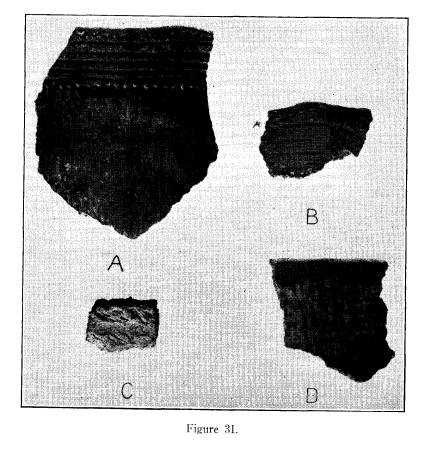
|
just below lip, 25mm. long, 7mm. wide, 4mm. high, with four trans- verse incisions on its surface. 2 shell-tempered. 3.2 Punctate rows above and below horizontal lines. 12 grit-tempered. Fig. 31, A: Cross-section, Figure 28, j. One has a notched lip, the notches ex- tending diagonally across lip and down outer surface of vessel for the distance of their depth. 3.3 Punctate rows above horizontal lines only. 31 grit-tempered. The punctate marks are for the most part irregularly round or square. One sherd also has round punctate marks in lip, (Figure 27, E.). 3.4 Punctate rows below horizontal lines. 3.41 Without other embellishment. 5 grit-tempered. One has a wide scallop, as in Fig- ure 31, B. The punctate marks ap- pear to have been gouged out in another. 3.42 Notches across lip. 1 shell-tempered. 3.43 Notches in outer edge of lip. 4 grit-tempered. 3.5 Notches in lip. 3.51 In outer edge of lip. 7 grit-tempered. 2 shell-tempered. 3.52 Notches across lip. 2 grit-tempered. 3.6 Punctate grows between horizontal lines. |
REEVE VILLAGE SITE EXCAVATION 49
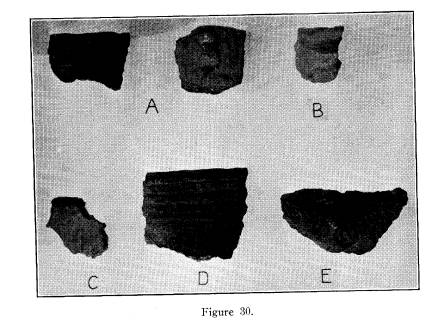
|
|
3.61 No other embellishment. 1 grit-tempered. 3.7 Short slanting lines just below lip. 3.71 No other embellishment. 2 grit-tempered. Lines pressed on one, and stamped with rectangular outline on the other. 3.72 With notches across lip. 1 grit-tempered. The short punctate lines on this sherd show a molded appearance with edges irregularly pressed over (Figure 31, C. Cross-section, Fig- ure 28, c.). 4. Parallel Incised Lines in Two Groups at Right Angles. 4.1 No other embellishment. 1 grit-tempered. Fig. 31, D: Cross-section Figure 28, h. The lines are scarcely more than a smoothing of the "fabric mark." 5. Diagonal and Horizontal Incised Lines. 5.1 Without notches or punctate marks. I I grit-tempered. Fig. 32, A: Cross-section, Figure 29, r. 5.2 Notches in outer edge of lip. 3 grit-tempered. 5.3 Short punctate or incised lines, vertical or slightly slanting, just below lip. 2 grit-tempered. One has a wide scallop (Figure 32, B. Cross-section, Figure 29, s.) with three small punch-marks ap- parently representing a face. 5.4 With punctate rows. 5.41 Above and below incised lines. 2 grit-tempered. |
50 OHIO ARCHEOLOGICAL AND HISTORICAL QUARTERLY
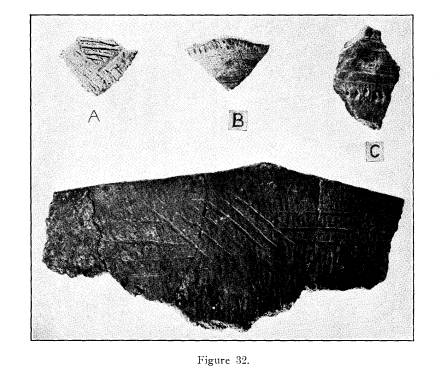
|
|
5.42 Above incised lines only. 1 grit-tempered. This may have had a punctate row beneath incised lines before it was broken. 5.43 Below incised lines only. 1 grit-tempered. Fig. 32, C: Cross-section, Figure 28, j. Notches in outer edge of lip. 5.5 Notches in outer edge of lip and extending nearly across lip. 1 both grit and shell tempered. Fig. 32, D: Cross-section, Figure 29, t. This sherd is a portion of a vessel about 18 inches in diameter. The sherd is from that portion bearing a scal- lop about 8 inches long, with six notches in lip at apex of scallop. 6. Diagonal Incised Lines Parallel. 6.1 Lip unnotched. 5 grit-tempered. Fig. 33, A: Cross-section, Figure 29, u. 6.2 Lip notched. 6.21 Notches in outer edge. 4 grit-tempered. 6.22 Notches across lip. 3 grit-tempered. All three sherds from the same vessel. The notches are at an ob- lique angle, and the diagonal lines and the notches have a molded rope- like appearance, with a punctate row beneath the diagonal lines. 6.3 Notches in outer surface of vessel beneath a widening of lip. 1 grit-tempered. |
REEVE VILLAGE SITE EXCAVATION 51
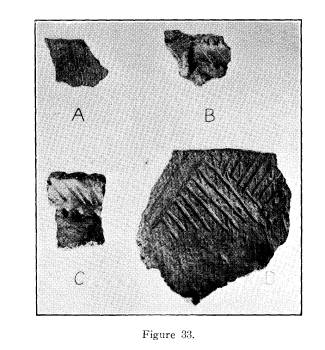
|
|
6.4 With crimping. 4 grit-tempered. The crimped pattern is above the diagonal lines. One sherd has a handle, flat in cross-section (Figure 33, B, cross-section, Figure 29, q.). Another has a punctate row at the shoulder. 7. Diagonal Lines, Incised, in Parallel Groups at Angles. 7.1 Lips unnotched. 9 grit-tempered. 2 shell-tempered. Fig. 33 D: Cross-section, Figure 29, w. 7.2 Lips notched. 4 grit-tempered. Notches in outer edge of lip. 8. Crimped Pattern, without Incised Lines. 8.1 Crimping in a ridge of clay which has been added to rim just below lip. 41 grit-tempered. One sherd (Figure 34, A.) has three oval indentations diagonally placed at the shoulder (Cross- section, Figure 29, k.). Three other sherds have the vertical oval in- dentations at neck, but only one each, and in a fourth there are short oval indentations in two rows. One of these (Figure 34, B, with cross-section as in Figure 29, i.) has a group of three short scallops; another has a handle round in cross- section (Figure 34, C, with cross- section as in Figure 29, z.); and two have short notch-like scallops. 2 both grit and shell-tempered. |
52 OHIO ARCHAEOLOGICAL AND HISTORICAL QUARTERLY
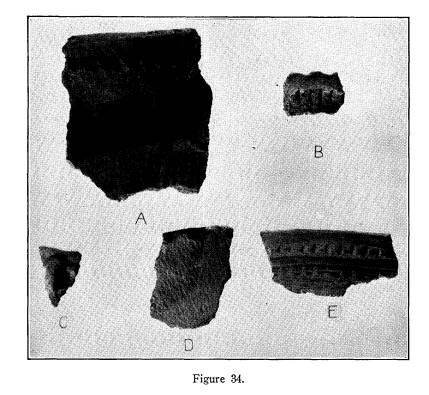
|
|
8.2 Crimping in outer edge of lip. Thickness of sherd across lip slightly more than farther down. 18 grit-tempered. Fig. 34, D: Cross-section, Figure 29, y. Fig. 36, E: Cross-section, Figure 29, y. One of these grit-tempered sherds has a scallop about one inch wide. 3 shell-tempered. 9. Crimped Pattern with Incised Lines. 9.1 Lines horizontal. 9.11 Without other embellishment. 21 grit-tempered. Fig. 34, E: Cross-section, Figure 29, k. Three sherds from the same vessel have only one horizontal line. One sherd has a double crimp, one line of crimping immediately above an- other. 9.12 With notches in lip. 2 grit-tempered. 9.13 With puctate rows. 9.131 Rows beneath horizontal lines. 3 grit-tempered. Fig. 35, A: Cross-section, Figure 29, k. Four notch-like scallops. 9.132 Punctate rows above horizontal lines. 4 grit-tempered. Probably from same vessel. 9.2 Lines diagonal, gouged. 9.21 Without horizontal lines. 1 grit-tempered. Fig. 35, B: Cross-section, Figure 29, g. Lines are short and slanting, and appear to have been gouged out with the thumb nail. They lie above the crimping. |
REEVE VILLAGE SITE EXCAVATION 53
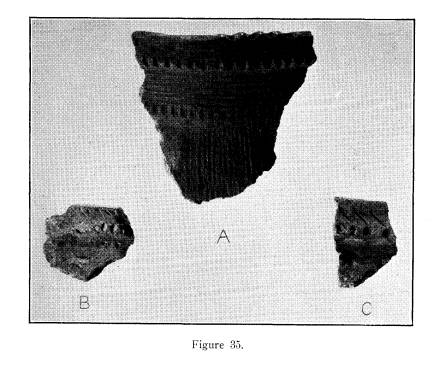
|
9.22 With horizontal lines. 1 grit-tempered. Fig. 35, B: Cross-section, Figure 29, x. The diagonal lines, which slant upward to the left, show a molded appear- ance. Just below the crimping is a row of punctate marks. This sherd originally had a handle, probably flat in cross-section. 10. Sherds with Crimped Pattern Fallen off. 10.1 Without other embellishment. 17 grit-tempered. One formerly had a handle, with an undeterminable cross-section. 2 shell-tempered. 10.2 With horizontal lines. 2 grit-tempered. Punctate rows above and below horizontal lines. Narrow notches just below lip. 10.3 Punctate rows below crimping. 1 grit-tempered. 10.4 Notches across lip. 1 grit-tempered. 11. With Curvilinear Lines. 11.1 With punctate rows. 2 grit-tempered. On one (Figure 36, A, with cross- section as in Figure 28, c.), the curved lines consist of a series of connecting punched squarish de- pressions. In the other there is crimping, fallen off, and a punctate row between crimping and the curved line. 11.2 With diagonal parallel lines, and short slanting lines just below lip. |
54
OHIO ARCHAEOLOGICAL AND HISTORICAL QUARTERLY
1 grit-tempered.
Fig. 36, B: Cross-section as in Figure
28, c.
The curved lines on this sherd may
be nothing more than poorly exe-
cuted straight lines. This sherd has
a wide scallop.
Pottery--Body Sherds, Decorated.
1.
Parallel Lines Only.
1.1 No other embellishment.
69 grit-tempered.
2 shell-tempered.
2. Parallel
Lines with Punctate Rows.
2.1 No other embellishment.
52 grit-tempered.
1 shell-tempered.
1 both shell and grit.
3. Parallel Lines in Groups at Angles to One Another.
3.1 At
oblique angles.
22 grit-tempered.
1 shell-tempered.
Four of the grit-tempered have
punctate rows.
3.2 At right angles.
2 grit-tempered.
1 shell-tempered.
4.
Crimped Pattern.
4.1 With
horizontal lines.
3 grit-tempered.
4.2 With diagonal lines in groups at
angles to one another.
1 grit-tempered.
5. Rows of Elliptical Punctate Marks.
5.1 No other embellishment.
1 grit-tempered.
Fig. 36, D.
6.
Curvilinear Lines.
6.1 No other embellishment.
REEVE VILLAGE SITE EXCAVATION 55
1 grit-tempered.
Fig. 36, C.
Catalog Number 2958 in the Ceramic
Repository, Ann Arbor,
Michigan, Pottery--Rim Sherds.
1. Plain.
1.1 Without handles or knobs.
6 grit-tempered.
1 shell-tempered.
2. Notches
in Lip, without Other Embellishment.
2.1
Notches in outer edge.
7 grit-tempered.
3. Horizontal Incised Lines.
3.1 Without other embellishment.
4 grit-tempered.
3.2 Punctate rows above and below
horizontal lines.
1 grit-tempered.
3.3 Punctate rows above horizontal lines
only.
2 grit-tempered.
3.7 Short slanting lines just below lip.
3.72 With notches across lip.
1 grit-tempered.
The notches are obliquely across
the lip. Cross-section of this sherd
Figure 27, F. The short slanting
lines are in the region indicated.
3.73 Punctate row below the horizontal
lines.
1 sherd.
6. Diagonal Incised Lines, Parallel.
6.1 Lip unnotched.
4 grit-tempered.
One sherd has a punctate row be-
low lip and above the diagonal lines.
6.2 Lip notched.
6.21 Notch in outer edge.
1 grit-tempered.
56 OHIO ARCHAEOLOGICAL AND HISTORICAL QUARTERLY
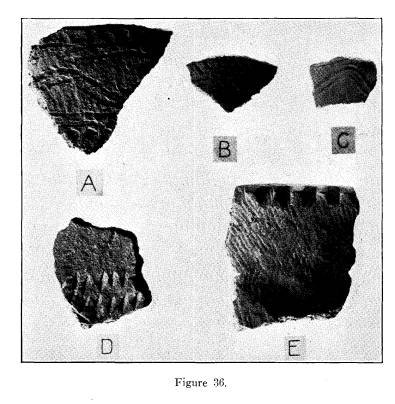
|
6.22 Notches across lip. 1 grit-tempered. 7. Diagonal Lines, Incised, in Parallel Groups at Angles. 7.1 Lips unnotched. 9 grit-tempered. In one, the two groups of lines are superimposed to make a crosshatch. Another sherd is shown in Figure 37, B. 7.2 Lips notched. 2 grit-tempered. 8. Crimped Pattern, without Incised Lines. 8.1 Crimping in a ridge of clay which has been added to rim just below lip. 10 grit-tempered. 8.2 Crimping in outer edge of lip. Thickness of sherd across lip slightly more than farther down. 2 grit-tempered. 9. Crimped Pattern with Incised Lines. 9.1 Lines horizontal. 9.11 Without other embellishment. 10 grit-tempered. 9.13 With punctate rows. 9.131 Rows beneath horizontal lines. 1 grit-tempered. 9.132 Rows above horizontal lines. 1 grit-tempered. 10. Sherds with Crimping Fallen off. 10.1 Without other embellishment. 8 grit-tempered. 10.2 With horizontal lines. 2 grit-tempered. 12. Raised Lines. 12.1 Lines diagonal and horizontal, with notches in lip and punctate rows on outer surface. 1 shell-tempered. Fig. 37, A: Cross-section as in Figure 28, h. |
REEVE VILLAGE SITE EXCAVATION 57
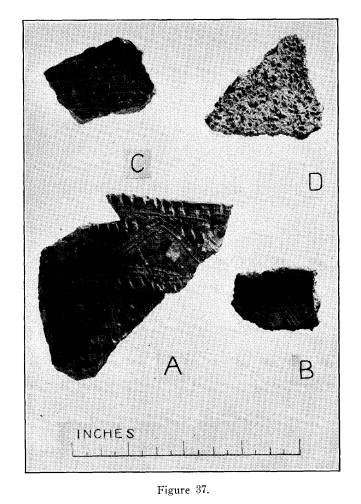
|
The lines in relief are at the general level of the surface of the sherd left between two rows of short in- cisions. The notches are at an ob- lique angle across the lip. There are two sets of roulette marks at the left end of the sherd. At the lip this sherd is 6mm. thick. At the outer end, 4mm. Both surfaces are very dark gray, and the interior is medium gray. Paste very fine in texture. Catalog Number 2958 in the Ceramic Repository, Ann Arbor, Michigan, Pottery--Body Sherds, Decorated. 1. Parallel Lines Only (Some have only one line). 1.1 No other embellishment. 22 grit-tempered. On two the lines are made by a roullette. 2. Parallel Lines with Punctate Rows. 2.1 No other embellishment. 12 grit-tempered. 3. Parallel Lines in Groups at Angles to One Another. 3.1 At an oblique angle. 6 grit-tempered. On two the separate groups are su- perimposed, forming a crosshatch. One is shown in Figure 37, C. 5. Rows of Punctate Marks. 5.1 7 grit-tempered. Surface Hardness This table is compiled by Mr. James B. Griffin and is based upon examination of 161 sherds in the Ceramic Repository, Museum of Anthropology, Ann Arbor, Michigan. These 161 sherds are representative of the entire collection. |
58 OHIO ARCHAEOLOGICAL AND HISTORICAL QUARTERLY
2 2. to 2.5 2.5 3
Shell temper, undecorated ..... 17 15
Grit temper, undecorated...... 16 8 2
Grit temper, decorated rim.....
28 19 1
Grit temper, outer rim-lip
notched, undecorated rim....
9 4
Grit temper, rim bears incised
lines
......................
18 7
Grit temper, added or thickened
upper rim strip, which has
perpendicular notches. Below
are horizontal lines and bi-
sected cones ............... 12 3
Shell temper, rim sherd....... 1
Grit temper, brickish red color
(Atypical) ............... 1
1 101 56 3
Catalog List
Accession Number 1o13.
Serial Number.
1. 2 large celts. Figure 7, B, C.
2. 1 celt. Figure 6, B.
1 celt. Division 1, no. 1, classification.
3. 1 celt. Division 4, no. 3.
4. 26 celts as follows:
1, Figure 6,
A.
2, Figure 3,
C, I.
5, Figure 5.
3, Figure 6, C, D, E.
2, Division 4, nos. 1, 2.
REEVE VILLAGE SITE EXCAVATION 59
6, Division 5.1, nos. 1-6.
6, Division 5.2, nos. 1-6.
1, Division 5.3, no. 1.
5. 1 large celt. Figure 7, A.
6. 1 pitted hammerstone.
7. 5 grinding stones, sandstone.
8. 2 hammerstones, gneiss.
9. 2
unfinished pipes. Figures 14, D, E.
10. 12 net-sinkers. Three in Figure 12, A, B, E.
11. 16
net-sinkers. Two in Figure 12, C, D.
12. 7
celts. Figure 4.
7 celts. Figure 3, A, B, D, E, F, G, H.
2 celts. Division 3, nos. 1, 2.
6 celts. Division 5.1, nos. 7-12.
1 celt. Division 5.3, no. 2.
1 celt. Division 5.4, no. 1.
1 rough piece of slate. Described in
text under
Miscellaneous Objects.
1 quartzite pebble. Described in text
under Miscel-
laneous Objects.
13. 1 projectile point. Figure 8, lower row, left end.
1 projectile point. Figure 8, lower row,
second from
right end.
1 projectile point. Figure 8, lower row,
right end.
2 projectile points. Figure 9, H, 1.
1 scraper, flint. Figure 10, F.
1 knife, stone. Division 1, no. 3.
2 projectile points. Division 1.2, nos. 1, 2.
5 projectile points. Division 1.3.
3 projectile points. Division 1.4.
1 projectile point. Division 1.5.
14. 1 projectile point. Figure 8, lower
row, second from
left end.
2 projectile
points. Figure 9, A, K.
1 scraper. Division 2.
1 drill. Division 1, no. 2.
60
OHIO ARCHAEOLOGICAL AND HISTORICAL QUARTERLY
15. 8 projectile points. Figure 8, upper row, except
fourth from right end.
64 projectile points. Division 1.1.
3 projectile points. Division 1.5.
6 projectile points. Division 1.6.
1 projectile point. Figure 9, G.
1 drill, flint. Figure 10, O.
16. 1 projectile point. Division 1.
3 projectile points. Division 1.3.
2 projectile points. Division 1.6.
1 knife. Division 1, no. 2.
17. 1 projectile point. Division 1.1.
2 projectile points. Division 1.3.
14 projectile points. Division 1.6.
4 scrapers, flint. Division 2.
1 scraper, flint. Figure 10, K.
1 knife. Figure 10, C.
2 blanks, flint. Figure 10, A, B.
18. 1 scraper, flint. Figure 10, H.
1 scraper, flint. Figure 10, M.
5 scrapers, flint. Division 1.
1 scraper, flint. Figure 10, G.
19. 4 drills, flint. Figure 10, D, E, I,
J.
20.
7 scrapers, flint. Division 2.
1 scraper flint. Figure 10, L.
2 drills, flint. Division 1, nos. 1, 2.
1 drill, flint. Figure 10, N.
3 knives, flint. Division 1, no. 1.
1 knife. Division 2.
1 projectile point, flint. Figure 8,
fourth from right
end.
1 projectile point, flint.
Division 1.1.
2 projectile
points, flint. Division 1.3.
15 projectile points, flint. Division
1.6.
40 projectile points, broken. Division
1.7.
21.
1 pendant of red slate. Figure 19, H.
REEVE VILLAGE SITE EXCAVATION 61
1 pendant of gray slate. Division 5.2.
Not perfo-
rated.
22. 1 gorget of red slate. Figure 19, G.
2 gorgets,
slate. Division 5.1, nos. 1, 2.
1 gorget, slate. Division 1.
Parallel scratches on
one face.
1 gorget, slate. Figure 19, B.
5 gorgets, slate, broken. Figure 19, A,
C, D, E, F.
23. 7 projectile points, flint. Figure
9, B, C, D, E, F, J, L.
24. 1 tobacco pipe. Figure 21, B.
25. 1 tobacco pipe. Figure 21, A.
26. 5 fragments of stone tobacco pipes.
Figure 23.
7 fragments of clay tobacco pipes.
Figure 24.
27. 1 comb, made of antler, five
pronged. Four prongs
missing but restored.
28. 1 comb, made of antler, five
pronged. Three prongs
missing but restored.
29. 1 gouge, antler, cutting edge
polished on back side.
30. 2
gouges, antler. Figure 11, lower
row, the two at
right.
5 gouges, antler, resembling those in
Figure 11.
31. 1 chisel, antler. Figure 11, lower row, second from
right.
32. 1 chisel, antler. Figure 11, top.
3 chisels, antler, resembling that in
Figure 11.
1 punch, antler. Three
longitudinal slits.
33. 11 flint-chipping tools, antler. Two
in Figure 16, B.
34. 3 projectile points, antler. Figure
11, lower right
end, and Figure 16, F.
35. 38 beads, made of bird leg-bone,
found around the
pelvis of the child in the burial.
Figure 2, Figure 20.
69 small shell beads, discoidal, found
beneath the
string of bone beads around the pelvis
of the child
in the burial. Figure 20, within the
circle formed
by the string of larger beads.
36. 2
tubes made of hollow bird bones, with
flute-like
stops.
62
OHIO ARCHAEOLOGICAL AND HISTORICAL QUARTERLY
37.
1 bone awl, blunt end missing. Figure 15,
N.
38. 1 two-tined bone awl. Figure 15, M.
39. 5 awls, bone, notched. One in Figure
15, C.
16 awls, bone, unnotched. Similar to
Figure 15, C
40. 7 awls, made of leg-bones of small
animals, resemb-
ling that in Figure 15, F.
41. 12
awls, made of split leg-bones of animals.
Two
are shown in Figure 15, O, G.
4 punches, bone.
42. 1 double-pointed awl, bone. Figure
15, H.
43. 5 bone awls. One shown in Figure 15,
J.
1 bone awl. Figure 15, K.
1 bone awl. Figure 15, L.
1 bone awl, notched as are those
numbered 39.
2 awls, made of split leg-bones of
animals.
1 awl, bone, double-pointed. Figure 15,
I.
3 flint-chipping tools, bone, broken.
1 fragment of a bone awl, 95mm. long.
Flat rib-bone.
2 flint-chipping tools, penis-bone of
raccoon.
1 flint-chipping tool. Figure 16, D.
49 fragments of awls of various types.
44. 61 beads, made of hollow leg-bones
of birds. Includ-
ing those in Figure 18, A, B, C.
45. 1 hollow and polished leg-bone of a
large animal.
One end partially restored.
46. 1 polished and cut bird bone, with a
crosshatched
band incised near one end.
47. 2
bear canines, perforated. Figure 18, I, J.
1 bear canine, with unfinished
perforation.
2 teeth,
perforated, one an elk incisor. Figure 18,
F, G.
48. 5 bear canines, unworked.
1 elk canine, one end missing.
49. 10 beaver incisors, unworked. One in
Figure 16, H,
right.
1 woodchuck incisor, unworked. Figure
16, H, left.
50.
1 goose leg-bone, cut off below articular
surface.
REEVE VILLAGE SITE EXCAVATION 63
3 fragments of flint-chipping tools. Two
flat.
1 flint-chipping tool. Figure 16, A.
1 piece of deer antler, perforated
longitudinally.
4 antler tips, 96-69mm. long. One with
groove en-
circling the tip.
2 projectile
points, antler. Division 3, nos. 1, 2.
1 flint-chipping tool. Figure 16, E.
51. 4 flint-chipping tools, penis-bone
of raccoon. Figure
16, C, shows two.
52. 1 hollowed-out deer metatarsus.
53. 1 shell pendant, mussel shell.
2 pieces
of mussel shell, worked. Figure 17, top row,
the two at the right.
54. 15 fish-scalers, made of mussel
shell. Some perfo-
rated, others with edges modified. Two
in Figure
17, lower row, and two perforated.
55. 28 fragments of mussel shells, none
showing use.
56. 31 mussel shells, some with
alteration at edges. One
is in Figure 17, lower right.
57. 1 iron hook, five inches long,
without barb.
58. 327 rim sherds.
59. 107 potsherds, large pieces.
60. 980 body sherds.
61. 1 lot of about 1000 animal bones,
including those of
fish and birds. Most numerous are those
of the bear,
deer, elk, wild cat, beaver, porcupine,
fox, raccoon,
and fish bones. Pieces of antler are
also included,
as is the basal portion of elk antler
described in text
under Miscellaneous Objects.
Identification of these
bones made by Mr. Robert Goslin.
62. 2 complete skeletons, one female
adult, one child.
63. 1 tobacco pipe, stone, in effigy of
the owl. Broken.
Found by Mr. Thomas Donkin some months
after
the excavations in 1929. Presented to
the Museum
March, 1932.
Vol. XLIV--5
64
OHIO ARCHAEOLOGICAL AND HISTORICAL
QUARTERLY
Ceramic Repository, Ann Arbor, Michigan.
Catalog Number 2958.
75 rim sherds. Two are shown in Figure
37, A, B.
47 body sherds, with decoration. One
shown in
Figure 37, C.
70 body sherds, without decoration. One
shown in
Figure 37, D.
